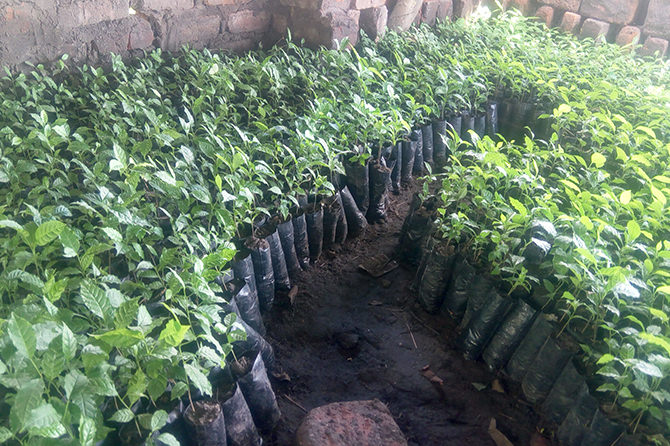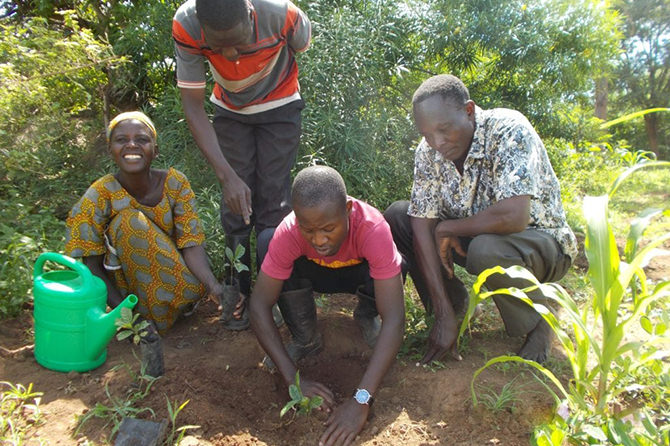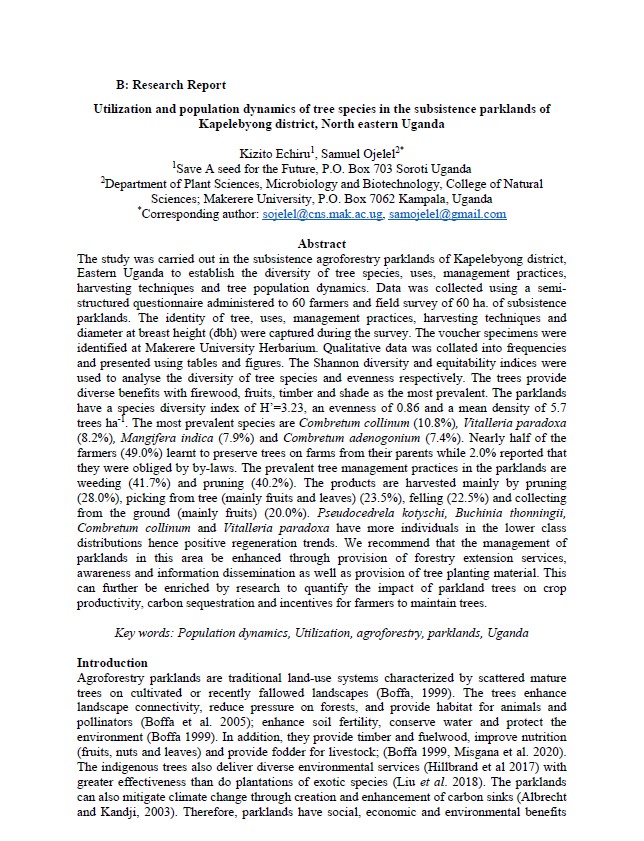2019 UGANDA
Revitalizing the role of agroforestry parklands in conserving biodiversity and improving livelihoods in the sub-humid drylands of Uganda
Save A seed for the Future (SAFE)
Community / field-based implementation
Landscape
Overview
Subsistence farmers make up over 90% of the households in the project area, and they are actively engaged in crop cultivation (groundnuts, cassava, millet, cowpeas) and rearing of livestock such as cattle, goats and sheep. The area is a sub-humid dryland with scattered swamps and tributaries. This Socio-Ecological Production Landscape (SEPL) has undergone large scale land-conversion into agricultural land, and there has been overexploitation of indigenous trees to provide wood fuel.
To cope with such socio-environmental issues, we set the following objectives:
1. Document the diversity of tree species, utilization and management in the remnant agroforestry parklands of Kapelebyong district, Uganda
2. Enhance community awareness and knowledge on the value, establishment and management of agroforestry parklands
3. Enrich 1,500 hectares of cultivated fields with at least 12,000 trees to increase habitat suitability and improve connectivity, as well as conserving biodiversity and diversifying farm output and household income
In our intervention, we set out to revitalize the practice of trees on farms (parklands) in the sub-humid drylands of Kapelebyong district where 91.9% of the households are subsistence farmers. We worked with 12 registered farmer groups to comprehensively document tree diversity, utilization and management in remnant agroforestry parklands. We conducted five community awareness and sensitization meetings on agroforestry parklands, held two awareness radio talk shows on Teso Broadcasting Services 87.6 FM and planted 14,500 indigenous tree seedlings in 1500 hectares of cultivated fields. We generated knowledge on the diversity of trees in agroforestry parklands of Kapelebyong district, and contributed towards shaping of community attitudes and behaviors towards the conservation of trees on farms (parklands) and tree planting in general. Additionally, our project has contributed to different national and global targets on on-farm biodiversity conservation and enhancement of carbon sinks.
Key achievements
- We generated knowledge on the diversity of trees in agroforestry parklands of Kapelebyng district. This is contained in a manuscript in Annex 3.
- We also contributed to shaping community attitudes and behaviors towards the conservation of trees on farms (parklands) and tree planting in general.
- Through our intervention of planting trees, the project has contributed to national as well as global targets on on-farm biodiversity conservation and enhancement of carbon sinks.
Lessons
- Parklands contain tree species that offer life support products and enhance biodiversity conservation on farms. It is pertinent to enlist local change agents in the community as a means of fueling desired change from within.
- We learnt that, upon completion of the project, there needs to be a framework for handing over activities to the local governments. This will enhance continuity, in addition to ensuring project specific sustainability.
- Where applicable, it is better to work with already-established community structures with clear leadership and mission. These act as change agents from within the community as opposed to those coming from outside.
Project location
Organisation

Save A seed for the Future (SAFE)
- Sector
- Non-governmental organisation
- Country
- Uganda
- Website/SNS
- https://saveaseedforthefuture.org/
Related products
Utilization and population dynamics of tree species in the subsistence parklands of Kapelebyong district, North eastern Uganda
- Publisher
- Save A seed for the Future (SAFE)
The study was carried out in the subsistence agroforestry parklands of Kapelebyong district, Eastern Uganda to establish the diversity of tree species, uses, management practices, harvesting techniques and tree population dynamics. Data was collected using a semi-structured questionnaire administered to 60 farmers and field survey of 60 ha. of subsistence parklands. The identity of tree, uses, management practices, harvesting techniques and diameter at breast height (dbh) were captured during the survey. The voucher specimens were identified at Makerere University Herbarium. Qualitative data was collated into frequencies and presented using tables and figures. The Shannon diversity and equitability indices were used to analyse the diversity of tree species and evenness respectively. The trees provide diverse benefits with firewood, fruits, timber and shade as the most prevalent. The parklands have a species diversity index of H’=3.23, an evenness of 0.86 and a mean density of 5.7 trees ha-1. The most prevalent species are Combretum collinum (10.8%), Vitalleria paradoxa (8.2%), Mangifera indica (7.9%) and Combretum adenogonium (7.4%). Nearly half of the farmers (49.0%) learnt to preserve trees on farms from their parents while 2.0% reported that they were obliged by by-laws. The prevalent tree management practices in the parklands are weeding (41.7%) and pruning (40.2%). The products are harvested mainly by pruning (28.0%), picking from tree (mainly fruits and leaves) (23.5%), felling (22.5%) and collecting from the ground (mainly fruits) (20.0%). Pseudocedrela kotyschi, Buchinia thonningii, Combretum collinum and Vitalleria paradoxa have more individuals in the lower class distributions hence positive regeneration trends. We recommend that the management of parklands in this area be enhanced through provision of forestry extension services, awareness and information dissemination as well as provision of tree planting material. This can further be enriched by research to quantify the impact of parkland trees on crop productivity, carbon sequestration and incentives for farmers to maintain trees.
Relevant projects
Projects of the same year
Aichi Biodiversity Targets
Aichi Biodiversity Targets
-
Awareness increased
-
Habitat loss halved or reduced
-
Sustainable agriculture, aquaculture and forestry
-
Ecosystems restored and resilience enhanced
-
Knowledge improved, shared and applied
Sustainable Development Goals
Sustainable Development Goals
-
No poverty
-
Gender equality
-
Decent work and economic growth
-
Responsible consumption, production
-
Life on land


